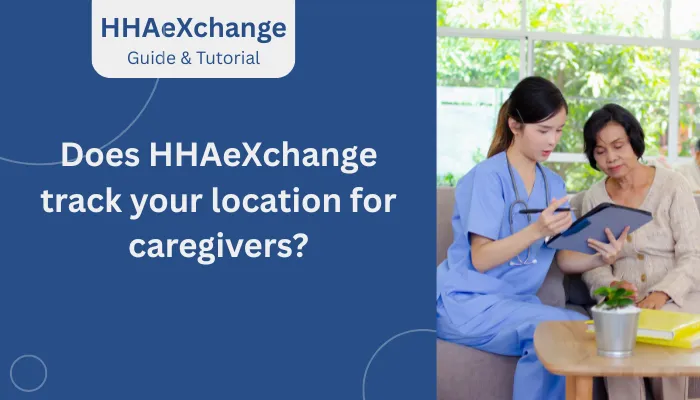I’ve used HHAeXchange as a caregiver, and the question Does HHAeXchange track your location for caregivers? often pops up when I talk with colleagues. As a caregiver, I know how critical it is to understand the tools we use daily.
This guide walks you through how HHAeXchange handles location tracking, why it matters, and what it means for us. I’ll break it down with clear steps, tips, and insights from my experience, so you can feel confident using the platform. Let’s dive into the details and clear up any confusion about location tracking in HHAeXchange.

How Does HHAeXchange Track Location?
When I first started using HHAeXchange, I wondered, Does HHAeXchange track your location for caregivers? The answer is yes, but it’s not as intrusive as it sounds. The platform uses location tracking to verify that I’m at the client’s location during scheduled visits.
This ensures accurate timekeeping and compliance with agency policies. HHAeXchange typically tracks location through its mobile app, which I use to clock in and out for shifts. The app captures my location only during these specific actions, not constantly throughout the day.
Here’s what I’ve found about how it works:
- Clock-In/Clock-Out Tracking: I clock in when I arrive at a client’s home, and the app records my location to confirm I’m there.
- Geofencing: The app uses a virtual boundary around the client’s address to verify I’m within the expected area.
- No Continuous Monitoring: Unlike some apps, HHAeXchange doesn’t track my location outside of work-related actions.
I appreciate that this setup respects my privacy while ensuring accountability. Let’s look at why this tracking happens.
Why Track Location in HHAeXchange?
When I consider Does HHAeXchange track your location for caregivers?, I realize it’s about accountability and efficiency. Agencies rely on accurate data to bill clients, comply with regulations, and ensure we’re providing care where needed. Here’s a table summarizing the key purposes:
| Purpose | How It Helps |
|---|---|
| Verify Visit Attendance | Confirms I’m at the client’s location for scheduled care. |
| Ensure Billing Accuracy | Matches my clock-in/out times and locations to billable hours. |
| Meet Compliance Standards | Helps agencies meet state and federal regulations for home care documentation. |
| Enhance Client Safety | Ensures clients receive care from verified caregivers at the right location. |
Knowing these reasons helps me see the value in tracking. Now, let’s explore how I manage it.
How to Manage Location Tracking?
When I think about Does HHAeXchange track your location for caregivers?, I focus on practical steps to use the system effectively. I ensure my phone’s location services are enabled before clocking in. The app prompts me to allow location access, which I confirm for accurate tracking. If I’m in an area with poor GPS, I notify my agency to avoid issues.
Here are my top tips for managing location tracking:
- Enable Location Services: I turn on GPS on my phone before starting a shift.
- Check Signal Strength: I ensure I have a good network connection for accurate clock-ins.
- Communicate Issues: If GPS fails, I contact my agency immediately to report the problem.
- Review Shift Logs: I check my shift details in the app to confirm accurate location data.
These steps make tracking straightforward and stress-free. Next, I’ll cover common concerns I’ve heard from other caregivers.
What Are Caregiver Tracking Concerns?
When caregivers ask me, Does HHAeXchange track your location for caregivers?, they often express concerns about privacy. I understand the unease, but I’ve found the system is designed with boundaries.
HHAeXchange only tracks my location during clock-in and clock-out, not my personal movements. If I’m worried about data security, I review the app’s privacy settings and ensure my phone is secure.
Common concerns and my responses:
- Privacy Invasion: The app doesn’t monitor me outside work hours, so my personal time remains private.
- Battery Drain: Location tracking uses minimal battery since it’s only active during specific actions.
- Accuracy Issues: If GPS glitches, I document my location manually and inform my agency.
Addressing these concerns helps me feel more comfortable with the system. Let’s look at the benefits I’ve noticed.
What Are Location Tracking Benefits?
I’ve discovered that location tracking offers advantages for us caregivers. Here’s what I’ve experienced.
Reflecting on Does HHAeXchange track your location for caregivers?, I see clear benefits. It simplifies my timekeeping, reducing paperwork and ensuring I’m paid accurately for my hours. It also builds trust with my agency, as they can verify my presence without constant check-ins. Plus, it protects me by documenting where I am during shifts, which can be helpful in disputes.
Here’s a numbered list of benefits I’ve found:
- Streamlined Timekeeping: Automatic location-based clock-ins save me time.
- Accurate Pay: Verified locations ensure my hours are recorded correctly.
- Agency Trust: Tracking shows I’m where I need to be, building confidence.
- Safety Net: Location data can protect me in case of scheduling or client disputes.
These perks make my job easier and more secure. Let’s wrap up with final thoughts.
Conclusion
I’ve navigated HHAeXchange’s location tracking and answered the question, Does HHAeXchange track your location for caregivers? with confidence. It’s a tool that supports accountability, ensures accurate billing, and simplifies my work as a caregiver.
By understanding how it works, managing it effectively, and addressing concerns, I’ve made it a seamless part of my routine. I encourage you to embrace the system, follow the tips I’ve shared, and communicate with your agency if issues arise.
